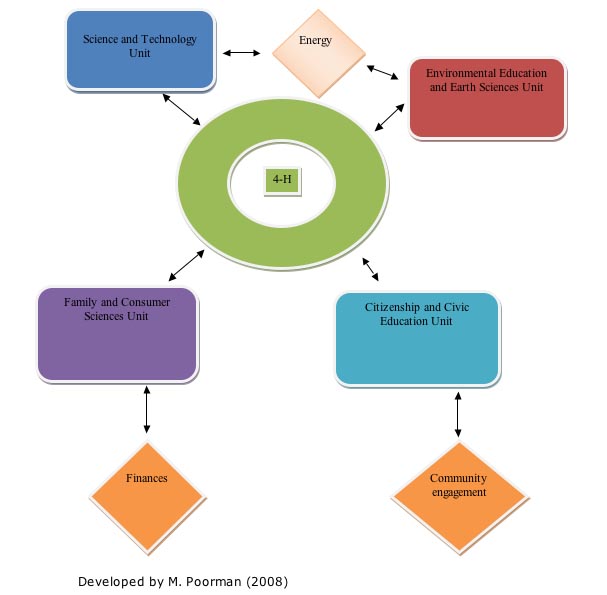 |
April 2010
|
April 2010 // Volume 48 // Number 2 // Tools of the Trade // v48-2tt7
Energy Efficiency: An Experiential-Based Energy Unit for Youth Ages 13-18
Abstract
Not all 16 year olds can buy hybrid cars to help save gas emissions, but they can learn new, easy ways to save energy. Youth are more likely to develop a greater sense of positive impact on the environment if they learn easy and creative ways to use energy more efficiently at a young age. Through the use of practical applications, youth can begin to make a difference in our environment. By implementing energy-related materials, programs like 4-H can teach communities the importance of saving energy. If youth are educated on ways to be energy conscious, they will teach others.
Introduction
There is major concern that if people keep producing greenhouse gases at increasing rates, the results will continue to be negative to the environment. Through the use of practical applications, youth can begin to make a difference in the environment and in their communities.
The Challenge
Recently, The National Energy Education Development (NEED) Project's newly developed curricula, Light and Lighting, Heat and Heating, and Energy in Motion, were introduced in Pennsylvania. However, Extension educators, 4-H leaders, and teachers have been hesitant to use these new curricula because many are not comfortable delivering content in the area of energy efficiency. This gap of knowledge and information has stifled the full implementation of these curricula to youth across the state. One way to assist educators in developing skills set and confidence in delivering energy efficiency information is by educating youth.
Youth have the right to be active citizens in the environment, but they are not taking action. It is important for them to be educated about the environment and decision-making processes. Hungerford and Volk's (1990) research supports the idea of learning by doing. When youth who were involved in school programs that only focused on environmental issues were compared with other programs that actually allowed students to design and implement environmental protection strategies in their communities, the youth who gained practical application were far more likely to continue using responsible environmental behavior in the future (Hungerford & Volk, 1990). Youth will be future leaders and may have the opportunity to make decisions about many factors that will protect or harm the environment. With the correct knowledge, those youth leaders will have a positive impact in their communities.
Youth need to be given the opportunities to learn and develop lifelong environmental protection and eco-friendly habits. If given opportunities through teaching and learning pedagogy such as service learning, they can begin to make better connections about what they are learning. Through practical applications a clearer association is made in understanding the relevance of the content.
A Practical Solution
In order to assist youth educators in delivering information on energy efficiency and to feel more comfortable in their delivery, an energy efficiency unit was created as part of a Master's thesis project. The goal of the project was to create materials that could be used in conjunction with The NEED Project's curricula or as a standalone unit. The supplemental materials in this unit can easily fit into any after-school or community program, such as 4-H. The toolkit includes a number of resources such as:
- Energy factsheets,
- Energy related handouts,
- Practical hands on activities, and
- Service-learning projects
Figure 1 illustrates how current units taught in 4-H relate to one another, yet relate back to energy efficiency. Energy-related materials and hands-on application will allow youth to realize the practical relevance of using energy more efficiently. Quality materials and resources will encourage youth to save energy now and to continue to do so in the future.
Figure 1.
An Energy Efficiency Unit
Relates to Four Major Units of the 4-H Program

The Supplemental Materials
The supplemental material and information provided in the unit will be a great benefit to any school curriculum, youth organization, club, or community group that wants to be more energy efficient and promote an eco-friendly lifestyle. It allows educators to more effectively teach easy ways to decrease energy use while actively engaging youth in the process.
The material can be used together as a unit or as stand-alone pieces to enhance a current curriculum and may be modified to be relevant to a particular community or state. The following is a list of the available resources and materials:
- Description of the Energy Efficiency Unit—Mission, purpose, and an example of a way the material in the unit can be used as study material for youth environmental competitions.
- Energy factsheets—Easy ways for youth to save energy.
- Web sites for teens—Fun and interesting websites youth can use to learn more about using energy more efficiently.
- Service-learning projects—Fun projects for youth to implement the knowledge they have gain from the materials in the unit.
- Alternative energy lesson—PowerPoint presentations, handouts, and a project on what alternative fuels are and how they can be used.
- CFL's—The benefits and cost effectiveness of compact fluorescent light bulbs.
- Energy efficiency notes—Basic information regarding energy efficiency from the EPA.
- Computer-based energy project—Ideas for energy-related projects for teens.
- Example of an action plan to reduce energy use. (This is only a sample template—the information should be reformatted to specific communities and states).
- Factsheets and other resources—New ideas, tips, and ways to reduce energy use. (Not just for teens).
- Web site resources—Lists of Web sites that are related to energy efficiency.
References
Hungerford, H., & T. Volk (1990). Changing learner behavior through environmental education. Journal of Environmental Education, 21 (3), pp. 8—21.
PA 4-H (2008). Pennsylvania 4-H. Retrieved April 9, 2008, from: http://pa4h.cas.psu.edu/Default.htm.



